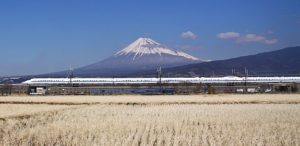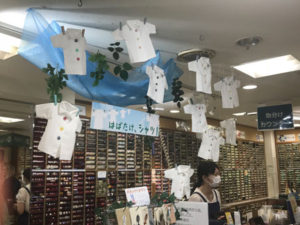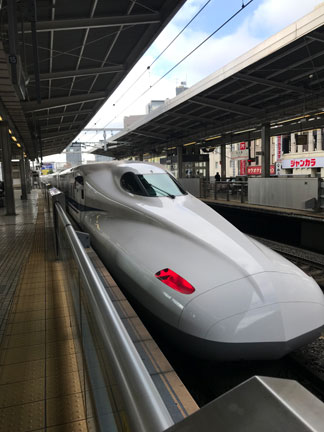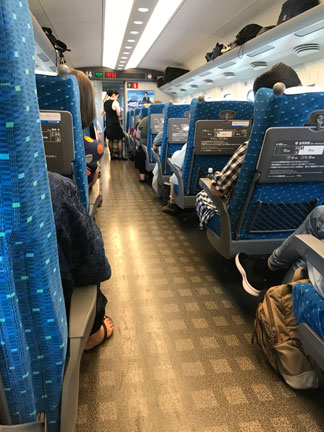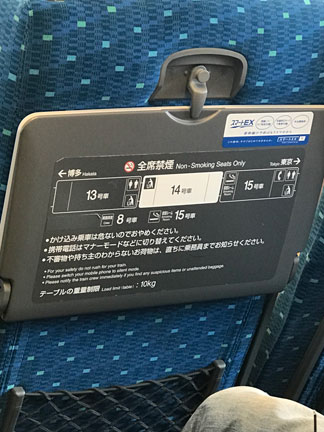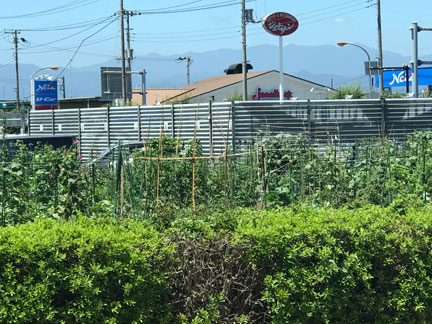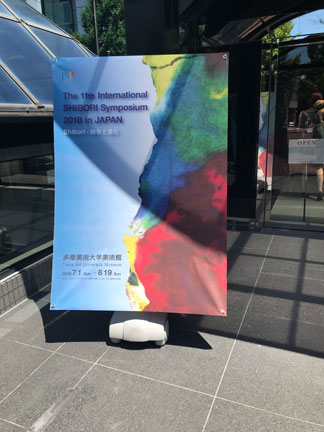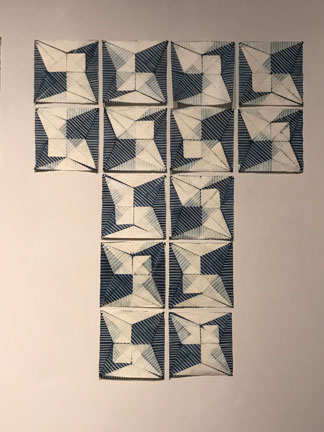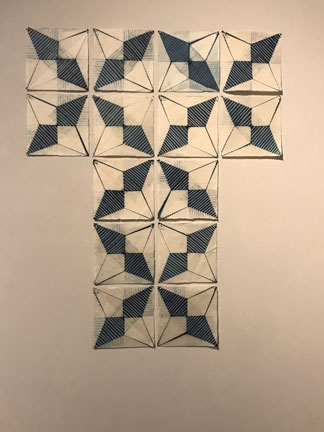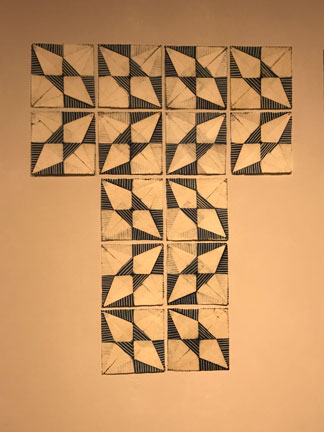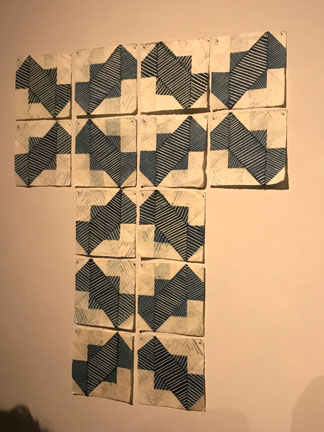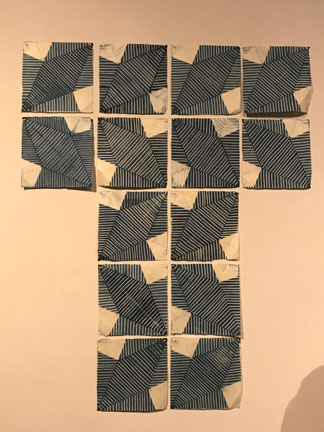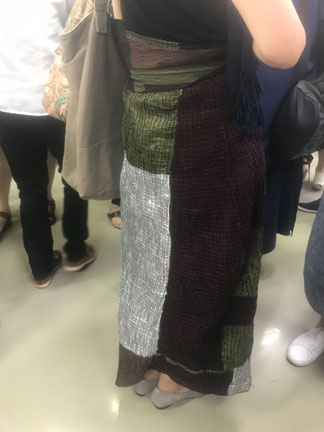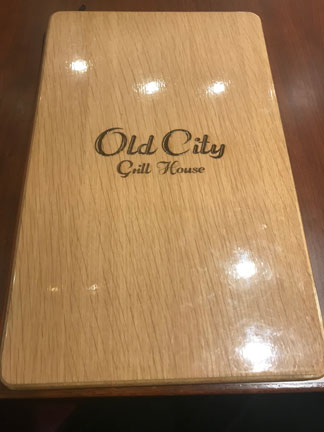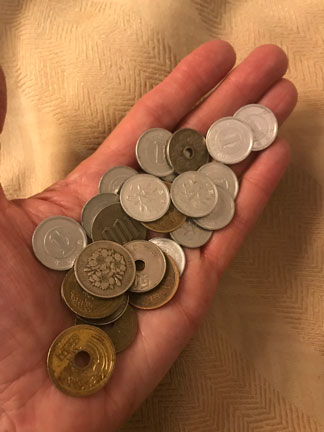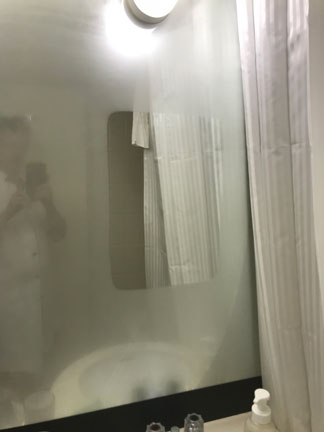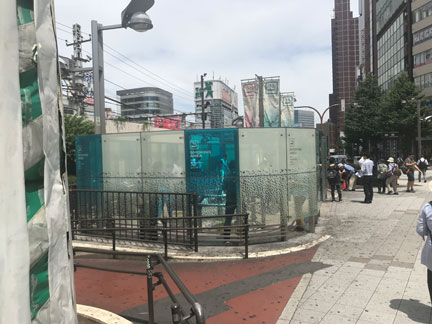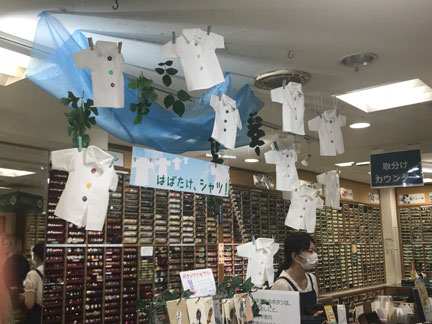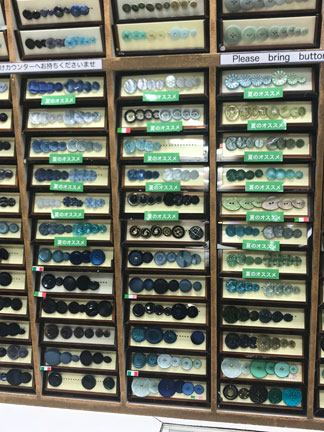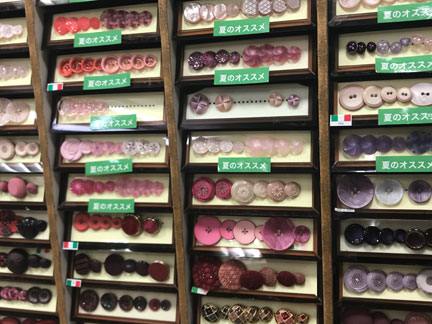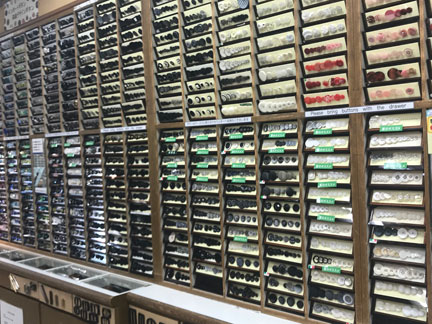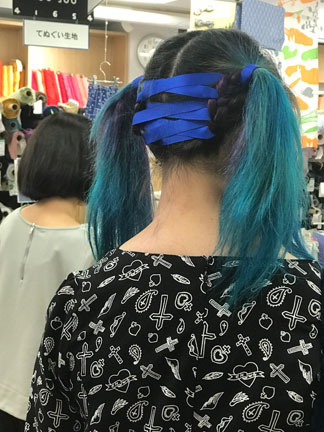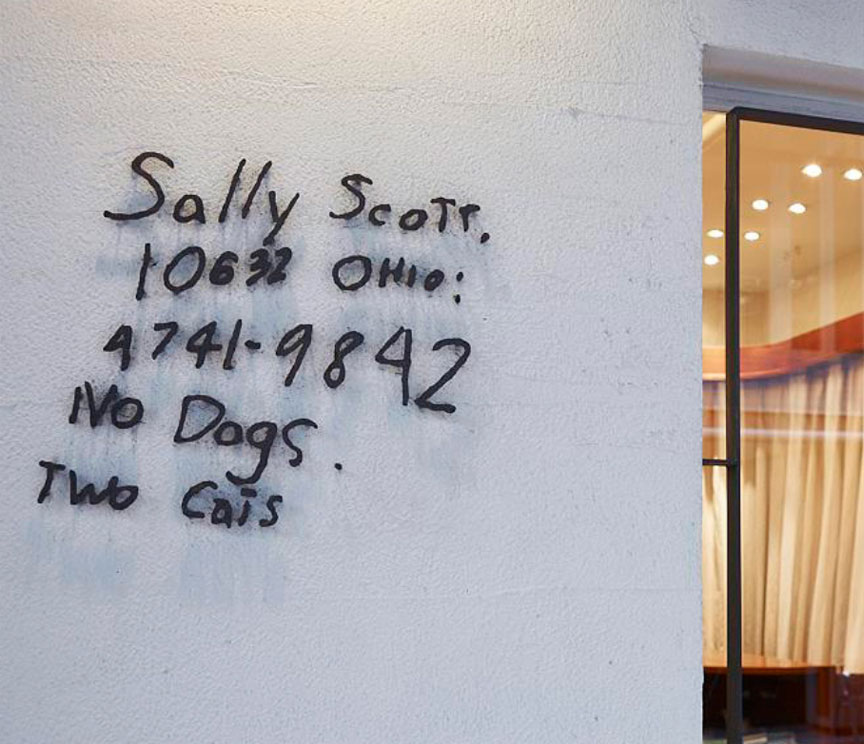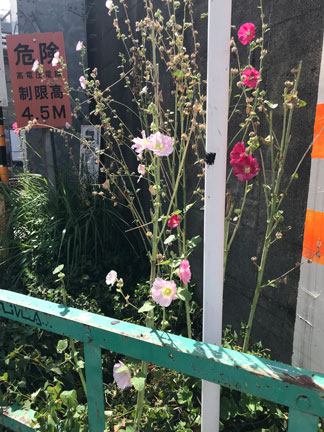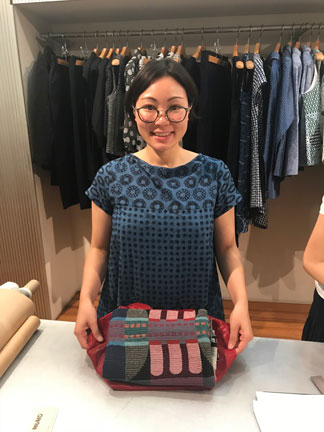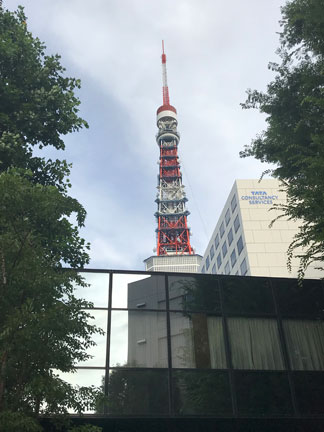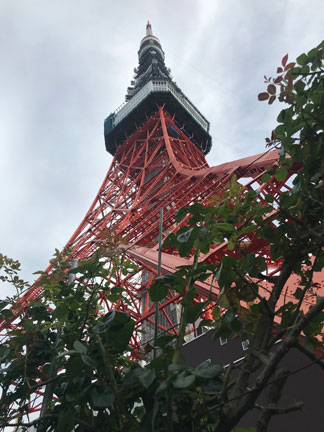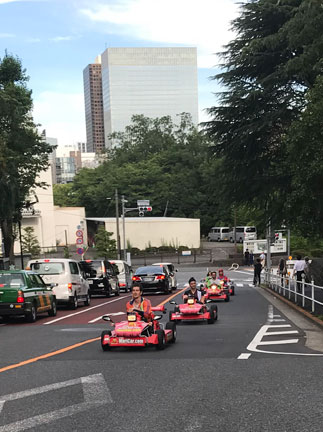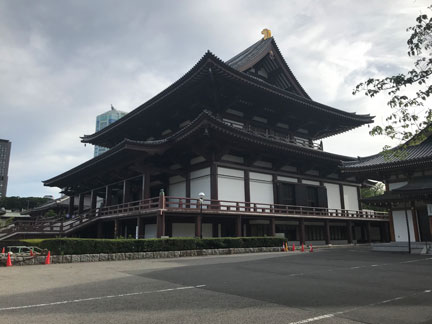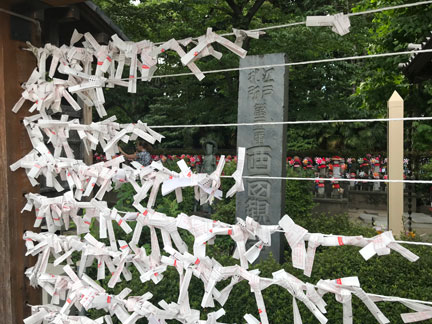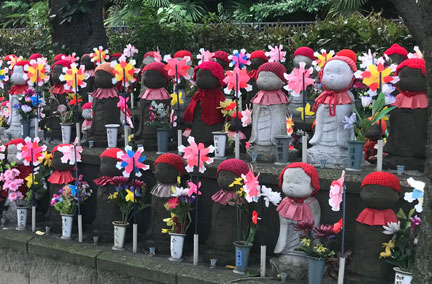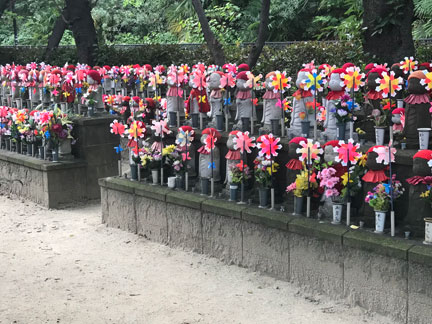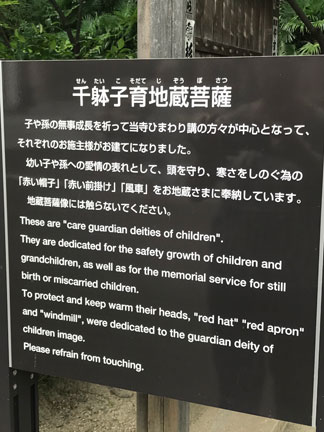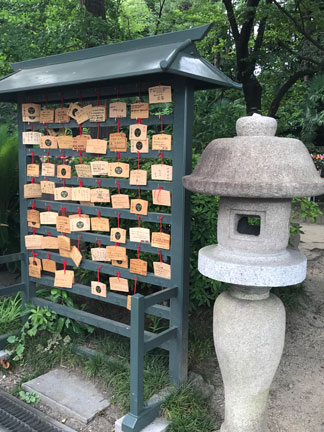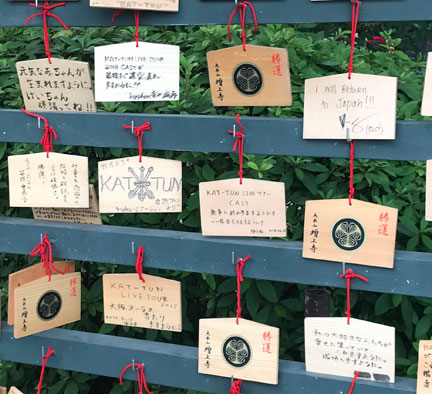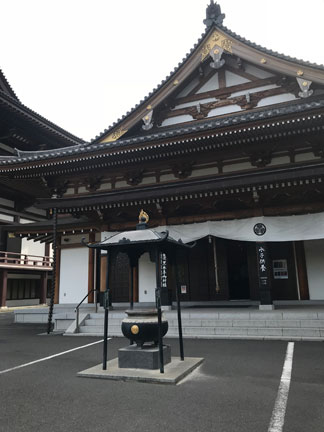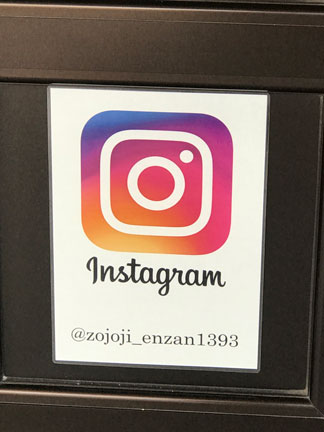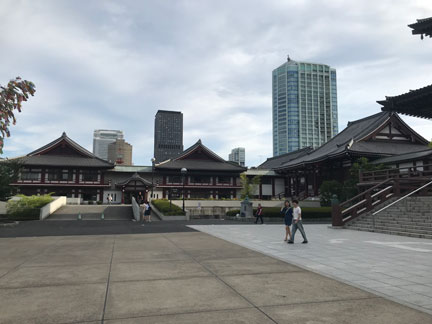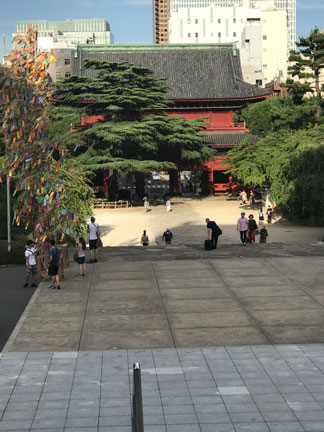A Very Fast Train; A Day for Shopping; Buddhist Prayers
Click here to jump to the photo gallery
Monday, July 2
Up and out early to catch the bullet train. The ride on the Shinkansen from Nagoya to Tokyo took 2½ hours. Probably the coolest vista of the trip, for me, was seeing the tip of Mt. Fuji to the north of the tracks.Upon arriving at the Yokohama station, we were transported by coach to the Keio Plaza Hotel in the Tama area of Western Tokyo, where a buffet lunch had been prepared for us. After lunch, we walked a few blocks to the Tama Art University Museum, where the exhibition, International Contemporary Art of Shibori, was on display. Some of the artists were our tourmates, others were local artists or TUAD students. After we had the opportunity to view the artworks on display, we went to the conference room in the basement of the museum where a “PechaKucha” session was held.
PechaKucha, or chit-chat, is a presentation format which began in Japan. It is sometimes referred to as 20×20—twenty slides, each displayed for twenty seconds. In the format used that afternoon, each speaker presented 15 slides displayed for 20 seconds each. The speaker narrates the slides and speaks to the subject for five minutes total. It’s a method used to present an overview of a topic in a concise manner. The speaker doesn’t lose the audience’s attention, and no one gets bored.
After the presentations, we went back upstairs, where the artists whose work was featured in the exhibition were introduced and honored. A small reception was held back downstairs, and then we boarded our coaches again and were delivered to our hotels. MaryLou and I were at the Shiba Park Hotel. Once we found our room, we went downstairs to the Old City Grill for dinner.
Tuesday, July 3
Excursion day. Rather than have planned excursions, we were given three printed pages listing local shops and museums that would be of interest to us. MaryLou and I connected with several of our friends for an extemporaneous excursion that began with a notions store and its sister fabric store, which was across the street. The Okadaya notions store was six stories tall, and appeared to be two joined spaces, one small and one much larger. Floor six was yarn in the large space (lots of Noro on half-price sale!) and leather in the small space. (Note that we didn’t spend a whole lot of time in any space, and I’m telling you what I remember, what grabbed my interest and my eye.) Floor five was buttons in the small space and notions in the large space. I bought a button for a lightweight fashion jacket I have at home whose button was lost about two years ago, and a pattern instruction book of Japanese fashion. These books are currently popular in the States among a certain category of sewist. The instructions are written in Japanese and not translated, but you get the pattern shapes and measurements, and intuit the instructions from the many illustrations. We moved down to the fourth floor, then decided to head across the street to see the fabrics.In the fabric store, the floors were divided by fabric or use type, much as we had seen on Saturday’s visit to the Otsukaya store. The first floor was cotton, second was wool, fourth was home dec, and so on. I saw the same seersuckers I was admiring on Saturday, touched a few bolts of fabric, and then we all felt we had had enough. Nell had already gone back to the hotel to rest for a bit, and the other six or seven of us split into two groups. Several of us headed to the Tokyo Takashimaya store, even larger than the store we had visited in Nagoya; one incentive was to visit the Tokyu Hands space in that larger store.
We started on the seventh floor and I saw lots of lovely stationary supplies and cutesy little Hello Kitty-type items, from the same manufacturer as the Hello Kitty line. To my delight, I saw a zippered pen case embroidered with a black cat and musical notes. It had an elastic strap on the back which can be slipped around a small notebook or journal. I had been wanting to make one of these for quite a while, so I was very happy to find this. The music and the cat: made for me!
Moving to the sixth floor, and walking across the side B lobby to the regular store sections on each floor, we walked through the fashions, then back into Tokyu Hands. As on Saturday in Nagoya, therewas a man here who would teach you how to make shoes. We saw a small selection of yarns (nothing like in Nagoya), and more handicraft supplies. We nosed through the garden supplies section, admired some darling bonsai trees, then decided it was time for lunch.
Floors 13 and 14 were filled with restaurants, basically a high-class food court. We checked out several on 14 (no smoking) and MaryLou went down to 13 (some smoking) and found a restaurant where I could get a bowl of spaghetti, there were tables available, and there was no smoking. It was wonderful to just sit and relax, although there appeared to be no sound-absorbing surfaces in the entire restaurant. It was terribly noisy and we had difficulty carrying on conversations.
We decided it was time to move back to textiles. There was a well-known store named Nuno, started by the man who originated nuno felting. We figured out how to get there by subway, and headed out.
After a 10-minute walk in the blazing sun and heat, a 15-minute subway ride, and a 15-minute walk, we ran into some of our tourmates, who pointed us around the corner to the basement entrance to Nuno. OMG. Fabrics like I had never seen. Most were in the $85-$100/meter range, and there was nothing I needed or wanted at that price point. But they had incredible scarves, both cotton (fall-spring) and wool (winter). I got a beautiful winter scarf in rich colors to go with any of my many black garments. And you know me and bags—they had a very cool bag design in a polyester that had been treated with a waterproof solution. I got the red one. (Remember my red leather bag from Sogo in Bali, and my new red leather shoes for this trip? It appears I’m in my “red period.”)
We left Nuno as more of our tourmates entered the small shop, spent some time exploring another shop in the building, then sat in the sidewalk café on the first floor to have a cool drink.
We had decided we would walk the 1.2 miles back to our hotel so we could see more of the outdoors, rather than tunneling back down to the subway. Looking at the map, I realized there was a large park on the route to the hotel. We followed that route, then walked right by the Zōjō-ji Temple near the hotel. What drew us into the temple grounds were all the statutes of small children wearing knitted red caps. This is the Sentai Kosodate Jizo, or Unborn Children Garden. So touching, so sad. (Here’s a blog post with some great photos that you might enjoy.)
We walked up to the temple and were very fortunate to be there at the time the evening prayers were being recited. I never learned who the woman was who walked up with the monk to the altar during the prayers.
Note: If you see three blank spaces on this page rather than embedded videos, please refresh your browser.
Tanabata is a traditional seasonal festival that occurs on the 7th day of the 7th month. Wishes are written on long strips of colored paper and tied to trees. Every hotel we walked into had several trees or large branches where people could tie their wishes. This tree was on the grounds of the Zōjō-ji Temple. The story of Tanabata.
Another display of paper we would see at temples we visited was omikuji, which are fortune-telling paper strips. Here’s a post with one explanation. It was explained to us very differently at one temple we visited. As I recall, people write wishes of issues or problems that they want to go away. Then they tie them to the omikuji rack (for lack of a better word). At the New Year, the strips are burned and therefore go away. Here’s another description I read while looking for the explanation I was given: “[T]here are several levels of Omikuji, the worst being a curse, and the best being a blessing. If you have a curse you should tie it to the purpose made strings tied between wooden poles at a shrine. The Omikuji tied there are taken and burned in a purification ritual, cleansing you of any bad luck.” That’s more as I understand it, and comes from this post.
Finally arriving back at the hotel, I checked my health app and was shocked and thrilled to learn I had logged 14,000 steps and over 6 miles during the day’s activities.
Then it was time to separate my bags. My large bag would be going by truck to Yamagata, where we would be reconnected in three days. My small rollaboard and my new backpack would go with me by train to Yonezawa and the ryokan. I hated that I was schlepping so much stuff and wished there had been a way to parse my belongings more. I carried on the train: my rollaboard with things I had needed on the plane or didn’t want to risk losing in my checked bag; the new backpack with three days’ change of clothes, medicines, toiletries; the ISS tote bag with water, notebook, and charging cords and into which I had stuffed my raincoat; my small leather purse/backpack, with tissues, lipstick, sunglasses—typical purse stuff; and my tiny crossbody bag with cash, passport, and phone. Really? This much stuff is ridiculous. I’m taking “bag lady” to new heights! If I had known before leaving home that we would be separated from our primary bags, I would have packed and planned differently. Alas, some things just can’t be helped. “[Luggage] is the central preoccupation of my life.”
A fancy dinner was being held at a nearby fancy hotel that night, but I had been having such a hard time eating all the Japanese food, I chose to just buy my own dinner at the steakhouse in the hotel. Additionally, I expected the diners would not arrive back to the hotel until 10:00, and I just can’t stay up that late after such a busy day and with an early departure the next morning.
Dropped my big suitcase in lobby, enjoyed a bowl of French onion soup and a caprese salad, finished assembling my bags, and slept well.



